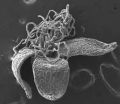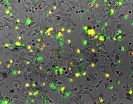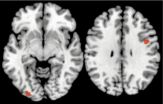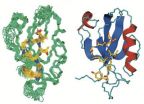(Press-News.org) Classroom rosters combined with human-networking theory may give a clearer picture of just how infectious diseases such as influenza can spread through a closed group of people, and even through populations at large. Using high-school schedule data for a community of students, teachers, and staff, Penn State University's Marcel Salathé, an assistant professor of biology, and Timo Smieszek, a post-doctoral researcher, have developed a low-cost but effective method to determine how to focus disease-control strategies based on which individuals are most likely to spread the infection.
The results of the study are being highlighted this week as an "Editor's Pick" in BioMed Central's open-access online journal BMC Medicine. The journal also is publishing a commentary on the study written by Gerardo Chowell, a member of the editorial board of BMC Medicine and an associate professor at Arizona State University, and Cecile Viboud. Both Chowell and Viboud are Epidemiology and Population Studies researchers at the U. S. National Institutes of Health.
The team's new findings build on earlier research in Salathé's lab addressing the challenge of counting the number of disease-spreading, face-to-face interactions within a closed group of people. "Theoretically, we know that people come into contact with many other people, that interactions vary in length, and that each contact is an opportunity for a disease to spread via small droplets that spread from the nose or mouth of one individual to another," Salathé said. "But it's very tedious and unreliable to ask people, 'How many different people have you been in contact with today, and for how long?' We knew we had to figure out the number of person-to-person contacts systematically."
In a 2010 research study, Salathé and his team asked volunteers at a high school to spend one school day wearing matchbox-sized sensor devices -- called motes -- on lanyards around their necks. Like a cell phone, each mote was equipped with its own unique tracking number, and each mote was programmed to send and receive radio signals at 20-second intervals to record the presence of other nearby motes. Volunteers then were asked to simply go about their day by attending classes, walking through the halls, and chatting with other people. At the end of the day, Salathé's team collected the motes and recorded how many mote-to-mote interactions had occurred, and how long each interaction had lasted.
Now, in their new study, Salathé and Smieszek have studied and recorded possible disease-spreading interactions with a different system. "Using motes is expensive and tedious," Smieszek explained. "We knew that for larger-scale and more-numerous studies to be feasible in the real world, we had to find a simpler way to get data about how people in communities interact. That's where classroom schedules came in." The team members gathered data from classroom rosters and formulated a "collocation rank" -- the cumulative time each individual is potentially exposed to other individuals -- for all students, teachers, and staff members at a high school. These collocation ranks were calculated from information about each class taught at the school -- which teacher taught the class, the room in which the class was taught, the period of the class, and the number of students who were enrolled in the class. "As you might expect, students had many more potential exposures than teachers, while janitors and office workers, who tend to work alone without many close interactions, had even fewer," Smieszek said.
The team members then compared their new classroom-schedule data to a computer model they had developed from the earlier motes study. Salathé explained that the motes study can serve as a highly reliable model of real-world interactions against which other data-collection methods can be compared for accuracy. "Data from the motes were collected systematically; all face-to-face interactions and the length of those interactions were recorded," Salathé said. "On the other hand, classroom data is somewhat fuzzier because it doesn't provide any information about between-class interactions, bathroom breaks, and possible absences. However, we found that when we compared results from the two data-collection systems, the difference was minimal. In other words, we have shown that classroom schedules can paint a fairly accurate picture of the frequency of person-to-person interactions, of which individuals have the most person-to-person contacts, and of the likelihood that disease will spread in the event of an outbreak."
Salathé and Smieszek hope that the classroom-schedule method of studying infectious-disease networks can be used in a number of ways. For example, if health officials need to ration limited doses of a new vaccine, schedule data could be used to determine which individuals have the most disease-spreading interactions. In addition, health officials could use information about more-susceptible individuals to target campaigns that raise awareness about vaccinations. "Ideally, all individuals should be vaccinated against an infectious disease," Salathé said. "But 100 percent vaccination is often not realistic, so we instead rely on 'herd immunity' -- a population-level immunity that occurs when a critical mass has been vaccinated." The team members also hope that a similar system could be developed to study other disease networks; for example, universities, workplaces, or even communities at large.
"One of the major obstacles for researchers studying the spread of infectious disease is figuring out how to determine how networks are structured and which are the highest-risk individuals," Smieszek added. "Methods that rely on network information that can be gathered with motes or surveys are expensive and involve a lot of coordination of volunteers. Our method is both cheap and simple, and is reliable and reflective of real patterns."
INFORMATION:
The research was funded by a fellowship from the German Academic Exchange Service (DAAD), a Branco Weiss Fellowship, and the National Science Foundation.
[ Katrina Voss ]
CONTACTS
Marcel Salathé: 408-386-8916, salathe@psu.edu
Timo Smieszek: 814-769-1217, smieszek@psu.edu
Barbara Kennedy (PIO): 814-863-4682, science@psu.edu
IMAGE
A high-resolution image associated with this research is online at http://www.science.psu.edu/news-and-events/2013-news/Salathe2-2013.
PREPRINT
The scientific paper, titled " A low-cost method to assess the epidemiological importance of individuals in controlling infectious disease outbreaks," can be found with the search function on the journal's website, http://www.biomedcentral.com/bmcmed/
GRANT NUMBERS
German Academic Exchange Service (DAAD) (D/10/52328)
National Science Foundation (OCI-0821527, BCS-0947132)
Flu outbreaks modeled by new study of classroom schedules
2013-02-13
ELSE PRESS RELEASES FROM THIS DATE:
Does race make a difference in monitoring of opioid pain therapy?
2013-02-13
Philadelphia, PA, February 12, 2013 – Opioids are frequently prescribed for pain management in noncancer patients, but recommended clinical guidelines for monitoring effectiveness and signs of drug abuse are often not implemented. Alongside well-documented racial disparities in prescribing opioid medications for pain, researchers report racial differences in the use of recommended opioid monitoring and follow-up treatment practices. The study is published in the current issue of PAIN®.
"In our study, we examined whether racial disparities exist in a more comprehensive ...
Ice age extinction shaped Australian plant diversity
2013-02-13
Researchers have shown that part of Australia's rich plant diversity was wiped out by the ice ages, proving that extinction, instead of evolution, influences biodiversity.
The research led by the University of Melbourne and University of Tasmania has shown that plant diversity in South East Australia was as rich as some of the most diverse places in the world, and that most of these species went extinct during the ice ages, probably about one million years ago.
The team's work was published in the prestigious journal Proceedings of the National Academy of Sciences.
Dr ...
Flood research shows human habits die hard
2013-02-13
New research has come up with ways to quickly assess flood damage to houses while also showing most people didn't intend to make changes to reduce their vulnerability after the 2010-11 floods in Australia.
Two separate reports from the National Climate Change Adaptation Research Facility released today show how lessons learned from households affected by the 2010-11 Australian floods can minimise damage under current and future climates.
The report Analysis of Damage to Buildings Following the 2010 Eastern Australia Floods evaluated the role of development controls ...
Blackbirds in the spotlight
2013-02-13
This press release is available in German.
Street lamps, traffic lights and lighting from homes are causing a rise in our night-time light levels. For some time now, scientists have suspected that artificial light in our towns and cities at night could affect plants, animals and us, humans, too. Studies, however, that have tested this influence directly are few. Scientists from the Max Planck Institute for Ornithology in Radolfzell, Germany, recently investigated how light conditions in urban areas at night affect European blackbirds (Turdus merula). They found that animals ...
Copper depletion therapy keeps high-risk triple-negative breast cancer at bay
2013-02-13
NEW YORK (February 13, 2013) -- An anti-copper drug compound that disables the ability of bone marrow cells from setting up a "home" in organs to receive and nurture migrating cancer tumor cells has shown surprising benefit in one of the most difficult-to-treat forms of cancer -- high-risk triple-negative breast cancer.
The median survival for metastatic triple-negative breast cancer patients is historically nine months. However, results of a new phase II clinical trial conducted by researchers at Weill Cornell Medical College and reported in the Annals of Oncology shows ...
UNC researchers discover gene that suppresses herpesviruses
2013-02-13
Chapel Hill, NC – Kaposi's sarcoma-associated herpesvirus (KSHV) and Epstein-Barr virus (EBV) hide within the worldwide human population. While dormant in the vast majority of those infected, these active herpesviruses can develop into several forms of cancer. In an effort to understand and eventually develop treatments for these viruses, researchers at the University of North Carolina have identified a family of human genes known as Tousled-like kinases (TLKs) that play a key role in the suppression and activation of these viruses.
In a paper published by Cell Host ...
'A drop of ink on the luminous sky'
2013-02-13
This part of the constellation of Sagittarius (The Archer) is one of the richest star fields in the whole sky -- the Large Sagittarius Star Cloud. The huge number of stars that light up this region dramatically emphasise the blackness of dark clouds like Barnard 86, which appears at the centre of this new picture from the Wide Field Imager, an instrument mounted on the MPG/ESO 2.2-metre telescope at ESO's La Silla Observatory in Chile.
This object, a small, isolated dark nebula known as a Bok globule [1], was described as "a drop of ink on the luminous sky" by its discoverer ...
Study suggests infant deaths can be prevented
2013-02-13
(TORONTO, Canada – Feb. 13, 2013) – An international team of tropical medicine researchers have discovered a potential method for preventing low birth weight in babies born to pregnant women who are exposed to malaria. Low birth weight is the leading cause of infant death globally.
The findings of Malaria Impairs Placental Vascular Development, published today online ahead of print in Cell Host & Microbe, showed that the protein C5a and its receptor, C5aR, seem to control the blood vessel development in the mother's placenta. Without adequate blood vessels in the placenta, ...
Carnegie Mellon brain imaging research shows how unconscious processing improves decision-making
2013-02-13
PITTSBURGH—When faced with a difficult decision, it is often suggested to "sleep on it" or take a break from thinking about the decision in order to gain clarity.
But new brain imaging research from Carnegie Mellon University, published in the journal "Social Cognitive and Affective Neuroscience," finds that the brain regions responsible for making decisions continue to be active even when the conscious brain is distracted with a different task. The research provides some of the first evidence showing how the brain unconsciously processes decision information in ways ...
Study in mice yields Angelman advance
2013-02-13
PROVIDENCE, R.I. [Brown University] — In a new study in mice, a scientific collaboration centered at Brown University lays out in unprecedented detail a neurological signaling breakdown in Angelman syndrome, a disorder that affects thousands of children each year, characterized by developmental delay, seizures, and other problems. With the new understanding, the team demonstrated how a synthesized, peptide-like compound called CN2097 works to restore neural functions impaired by the disease.
"I think we are really beginning to understand what's going wrong. That's what's ...





